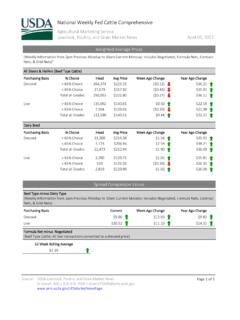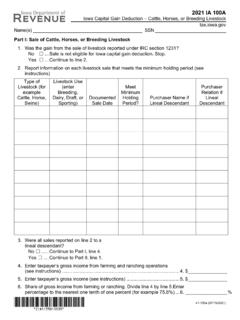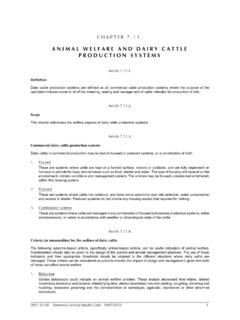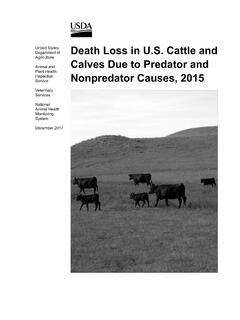Transcription of Code of Recommendations for the Welfare of Livestock: Cattle
1 CattleCode of Recommendations for the Welfare of LivestockPrinted on Recycled Paper containing 75% post consumer waste and 25% Elemental Chlorine Free virgin Publications, Admail 6000 London, SW1A 2XX Crown Copyright March 2003 PB 7949 Code of Recommendations for the Welfare of Livestock: CattleNoteAfter consultation, this code (which consists ofparagraphs 1-150) has been put before both Housesof Parliament for authority to issue it under Section 3of the Agriculture (Miscellaneous Provisions) Act 1968. This Section allows the Ministers to produce codesof Recommendations for the Welfare of livestock, andto issue such codes once they have been approved indraft by both Houses of Parliament. However, theoriginal definition of the Ministers (see Section 50 ofthe 1968 Act) has been changed to reflect devolutionfor Scotland and Wales and the creation of theDepartment for Environment, Food and Rural England, the powers of the Ministers were firsttransferred to the Minister of Agriculture, Fisheriesand Food by the Transfer of Functions (Agricultureand Food) Order 1999 ( 1999/3141) and thentransferred to the Secretary of State by the Ministry of Agriculture, Fisheries and Food (Dissolution) Order2002 ( 2002/794).
2 In Scotland, the powers of the Ministers hadpreviously been transferred to the Scottish Ministersby Section 53 of the Scotland Act 1998 (1998 )and, in Wales, the powers of the Ministers hadpreviously been transferred to the National Assemblyfor Wales by article 2(a) of the National Assembly for Wales (Transfer of Functions) Order 1999 ( 1999/672).Any reference in this code to advisory publications is for information only and does not form part of this and other emergency precautions2487-89 Section 2 Specific recommendationsPregnancy and calving2590-97 Calf rearing2698-120 General2698 Inspection2699-101 Sick and injured calves26102 Feed, water and other substances26103-110 Accommodation 28111-113 Moving and selling calves30114-115 Castration 30116 Disbudding and dehorning30117-119 Supernumerary teats31120 Breeding animals32121-134 Breeding32121-122 Inspection32123 Management32124-125 Natural service - bulls33126-127 Artificial insemination and embryo transfer33128-131 Ultrasound scanning34132 Bull pens34133-134 dairy cows35135-150 General35135-141 Mastitis35142 Milking36143-149 Robotic milkers36150 AppendixUseful publications37A Defra publications related to Cattle welfare37B Legislation related to Cattle welfare38C Other useful publications related
3 To Cattle welfare39 Further information39D Further information on Cattle identification and Cattle movements39 Code of Recommendations for the Welfare of Livestock: CattlePageParagraphsPreface2 Introduction51-6 Section 1 Recommendations for all cattleStockmanship67-22 General67-10 Inspection711-13 Handling714-16 Transport off-farm817 Marking918-21 Clipping922 Health1023-50 General1023-26 Condition scoring1027 Biosecurity1128-30 Lameness1131-33 External parasites1134 Internal parasites1235 Dosing and vaccination equipment1236 Notifiable diseases1237-38 Sick and injured animals1239-48 Downer animals1342-44 Record keeping1549-50 Feed, water and other substances1651-55 Accommodation1756-77 General1756-61 Straw yards1862-64 Cubicles1865-68 Cowsheds1969-72 Space allowances1973 Ventilation1974-76 Lighting1977 Equipment2178 Management2279-86 General2279-83 Fencing and hedges2284-85 Injurious weeds2286 Code of Recommendations for the Welfare of Livestock: CattleContents3 The Welfare of Farmed Animals (England)Regulations 2000 ( 2000 No.)
4 1870) Regulation10, provides that:-Any person who employs or engages a person toattend to animals shall ensure that the personattending to the animals:- is acquainted with the provisions of all relevant statutory Welfare codes relating to the animals being attended to;- has access to a copy of those codes while he is attending to the animals; and- has received instruction and guidance on those person who keeps animals, or who causes orknowingly permits animals to be kept, shall notattend to them unless he has access to all relevantstatutory Welfare codes relating to the animalswhile he is attending to them, and is acquaintedwith the provisions of those Regulation 2 it states that statutory welfarecode means code for the time being issued underSection 3 of the Agriculture (MiscellaneousProvisions) Act cause unnecessary pain or unnecessary distress toany livestock on agricultural land is an offence underSection 1(1) of the Agriculture (MiscellaneousProvisions) Act 1968.
5 The breach of a code provision,whilst not an offence in itself, can nevertheless beused in evidence as tending to establish the guilt ofanyone accused of causing unnecessary pain ordistress under the Act (Section 3(4)).The Welfare of Farmed Animals (England)Regulations 2000 ( 2000 No. 1870) Regulation3(1), states that: -owners and keepers of animals shall take allreasonable steps:- to ensure the Welfare of the animals under their care; and- to ensure that the animals are not caused any unnecessary pain, suffering or Welfare of Farmed Animals (England)Regulations 2000 ( 2000 No. 1870) Regulation3(3), states that:In deciding whether the conditions under whichanimals are kept comply with the requirements setout in Schedule 1 of the Regulations, the ownerand keeper of the animals shall have regard to theirspecies, and to their degree of development,adaptation and domestication, and to theirphysiological and ethological needs in accordancewith established experience and preface is not part of the code; instead, it explains the code s role and thebroad considerations on which it is based.
6 The legal text in shaded boxesthroughout this document is not part of the code either but highlights the legalposition. The text in these boxes is the law as it stands on the date that this code is published or reprinted (please turn to the back cover for this information). You should be aware that any of the legal requirements quoted here couldchange - you should check that these are an accurate statement of the law as it currently stands. (See the Appendix for a list of relevant legislation).The Welfare of Farmed Animals (England)Regulations 2000 ( 2000 No. 1870) Regulation11, states that:Where an authorised person considers that animalsare being kept in a way which is likely to causeunnecessary pain, suffering or injury, or in any otherway in contravention of any provision of theseRegulations, he may serve a notice on the personappearing to him to be in charge of the animalsrequiring that person, within the period stated inthe notice, to take any action that the authorisedperson considers to be reasonably necessary toensure compliance with these Regulations and theauthorised person shall give his reasons forrequiring that action to be Welfare of Farmed Animals (England)Regulations 2000 ( 2000 No.)
7 1870) Regulation13(2), states that:In any proceedings against an owner or keeper ofanimals for a failure to comply with Regulation 3(1)or 3(2), the owner or keeper as the case may be,may rely on his compliance with any relevantrecommendation contained in a statutory welfarecode as tending to establish his compliance withthe relevant code aims to encourage all those who care forfarm animals to follow the highest standards ofhusbandry. Without good stockmanship, animalwelfare can never be properly protected. If stock-keepers follow this code, it will help them to meet thenecessary Welfare standards. No matter howacceptable a system may be in principle, withoutcompetent, diligent stockmanship, the Welfare of theanimals cannot be adequately catered Welfare of Cattle is considered within aframework that was developed by the Farm AnimalWelfare Council and known as the Five Freedoms.
8 These form a logical basis for assessing animal welfarewithin any husbandry system, together with takingthe action necessary to protect animal Welfare withinthe limitations of an efficient livestock Five Freedoms are: 1freedom from hunger and thirst- by ready access to fresh water and a diet to maintain full health and vigour; 2freedom from discomfort- by providing an appropriate environment including shelter and a comfortable resting area;3freedom from pain, injury or disease- by prevention or rapid diagnosis and treatment;4freedom to express normal behaviour- by providing sufficient space, proper facilities and company of the animals own kind;5freedom from fear and distress- by ensuring conditions and treatment which avoid mental taking account of these freedoms, those peoplewho care for livestock should demonstrate: caring and responsible planning and management; skilled, knowledgeable and conscientious stockmanship; appropriate environmental design (for example, of the husbandry system); considerate handling and transport of animals; and humane code (which only applies in England) coversall Cattle .
9 Cattle refers to all bovine stock (such ascows and oxen), and includes buffalo and bison. A calf refers to any animal under six months code s Recommendations apply to cattleunder all husbandry systems. Section 1 of the codegives the Recommendations that apply to all agesand types of Cattle . Section 2 covers thoserecommendations that apply to specific categoriesof Cattle (such as calves, breeding Cattle and dairy ).If these Recommendations are followed, they willhelp to protect the stock s Welfare . The code srecommendations are not a complete list and theyare not meant to replace expert advice, such asfrom a veterinary husbandry system that is used, and thenumber and stocking rate of Cattle kept at any one time, should depend on: the suitability of the farm environment; how many animals the farm can accommodate at one time; the competence of the stock-keeper; and how long the stockmen have to carry out their duties.
10 4 Organic Cattle farming is conducted according toadditional, legally enforced standards. However,nothing in those standards affects the legalresponsibilities of organic farmers regarding positiveanimal Welfare . Any matters which appear to conflictwith organic standards should be discussed with yourorganic certifying body. In addition, you should seekexpert advice, such as from a veterinary general, the larger the size or the productivity ofthe herd, the more skill and care is needed to protectwelfare. No changes should be made to husbandry,equipment or production until the possible effects onanimal Welfare have been considered. 6 The relevant animal Welfare legislation applies toowners as well as to anyone looking after Cattle ontheir behalf, wherever the Cattle are located.














